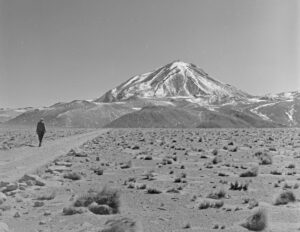Famous for its world-class collection of more than half a million maps and atlases, the American Geographical Society Library also boasts an extensive photograph collection, now nearing one million items, that is less well known.

However, as more of the photographs have been catalogued, digitized and placed online, the popularity of the collection—photographic prints, slides, and negatives in a variety of formats—has grown rapidly. In 2022, there were 123,573 pageviews of AGSL’s photographs.
Also in 2022, says longtime Visual Resources Librarian Susan Peschel, there were more than 200 requests for permission to use AGSL images, a record number.
Peschel, who is retiring this summer, has fielded a wide variety of such requests over the years. She says one of her favorites was from a UK based service, Black Dementia Company, asking for permission to employ images of Africa and the Caribbean for 16-piece puzzles to support people living with dementia.
Just a few of the many other interesting requests to which she has responded include
- a province in China wanting images taken by the globetrotting photojournalist Harrison Forman to create a huge outdoor exhibit for citizens to view their history;
- a Hong Kong jewelry store interested in a historical photo, also by Forman, of the store for an ad commemorating their 50th anniversary;
- an artist asking to use images of Thailand from the Robert Pendleton Collection—Pendelton was a soil scientist—to be screened at an exhibit of the artist’s sculptures inspired by those photos;
- and the Nelson Atkins Museum in Kansas City identifying Timothy O’Sullivan images for their catalogue raisonné of the celebrated 19th century photographer.
Peschel had worked with the collections at AGS in New York as a student and then joined the permanent staff after the 1978 transfer of the collections to UWM. In 2005 she accepted the daunting task to organize, catalog, and preserve the growing photographic collections.

To learn best practices, she attended seminars presented by the Library of Congress and the National Archives and warmed up with several small collections during the first year in her new role.
She began with the approximately 35,000 images originally listed in the AGS accession book, creating a database and re-organizing and re-housing many of the photos.
Since then, the database (and the collection) has grown to nearly 973,000 items, and, with the help of several major grants, many of the most valuable and endangered materials have been preserved. Some 80 photo collections—several approaching 100,000 items—have been acquired since AGSL moved from New York. Currently, only approximately 35,000 images remain unprocessed, although, Peschel says, “we continue to accept quality geography-related collections of photos,” and more than 125,000 photos are now online, offering global access.
Collections include photos from major exploration expeditions to the western United States and the Polar regions along with the collections of renowned photo journalists and scientists such as Harrison Forman, Loren McIntyre, Eugene Harris, and Clarence Sorenson. More information about the photo collections can be found on AGSL’s website.
In addition to her role managing the photographs, Peschel answers reference questions and especially relishes opportunities to bring together researchers investigating the same topic.

A particularly satisfying and fruitful set of connections began when she was trying but unable to identify one of three men in a photo taken at an AGS award ceremony in 1960. Several weeks later she received a letter from a woman in Hawaii with a copy of the same photo and a note asking if Peschel could identify the two men (whom Peschel had already identified) in the photo with the letter writer’s father, “William Rudolph.”
“Wow—what are the chances?” Peschel says. But the serendipity continued.
Checking the core collection of previously cataloged photos, she discovered a number of images taken by Rudolph, who was a mining engineer in the Atacama region of Chile. Not long after that, a graduate student contacted her looking for Isaiah Bowman’s images of the Atacama Desert for her dissertation. The student was unaware of the library’s other holdings and Peschel mentioned the William Rudolph images for consideration.
Peschel then connected the student with Rudolph’s daughter, and the two became good friends. Eventually, the Rudolph family donated their collection of his photographs, diaries and papers to AGSL. The graduate student, having become a professor, was awarded an AGSL fellowship, and later assisted with the identification of most of the newly acquired negatives. The result was an additional 1,500 Rudolph images uploaded to AGSL’s digital collections.

Over her 45-year career at AGSL, Peschel has worked in a variety of capacities, from “unpacking the mountain of boxes of material deposited on the floor of AGSL’s new space at UWM,” she says, to editing a geographical publication bibliography and cataloging maps and atlases, but it is her last position shepherding the photo collection that she has enjoyed most.
“Working with many researchers over the years, some repeatedly, has been especially rewarding,” she says. “As experts in their field, they have often provided many helpful value-added details to our records.”
Though Peschel is officially retiring in July, after a break she hopes to return as a volunteer and continue to contribute. She has been invited to speak about the Louise A. Boyd collection at a photo exhibit opening in London at the Royal Geographical Society in November 2023. And then, there are those 35,000 remaining images to accession.
—Steve Burnham